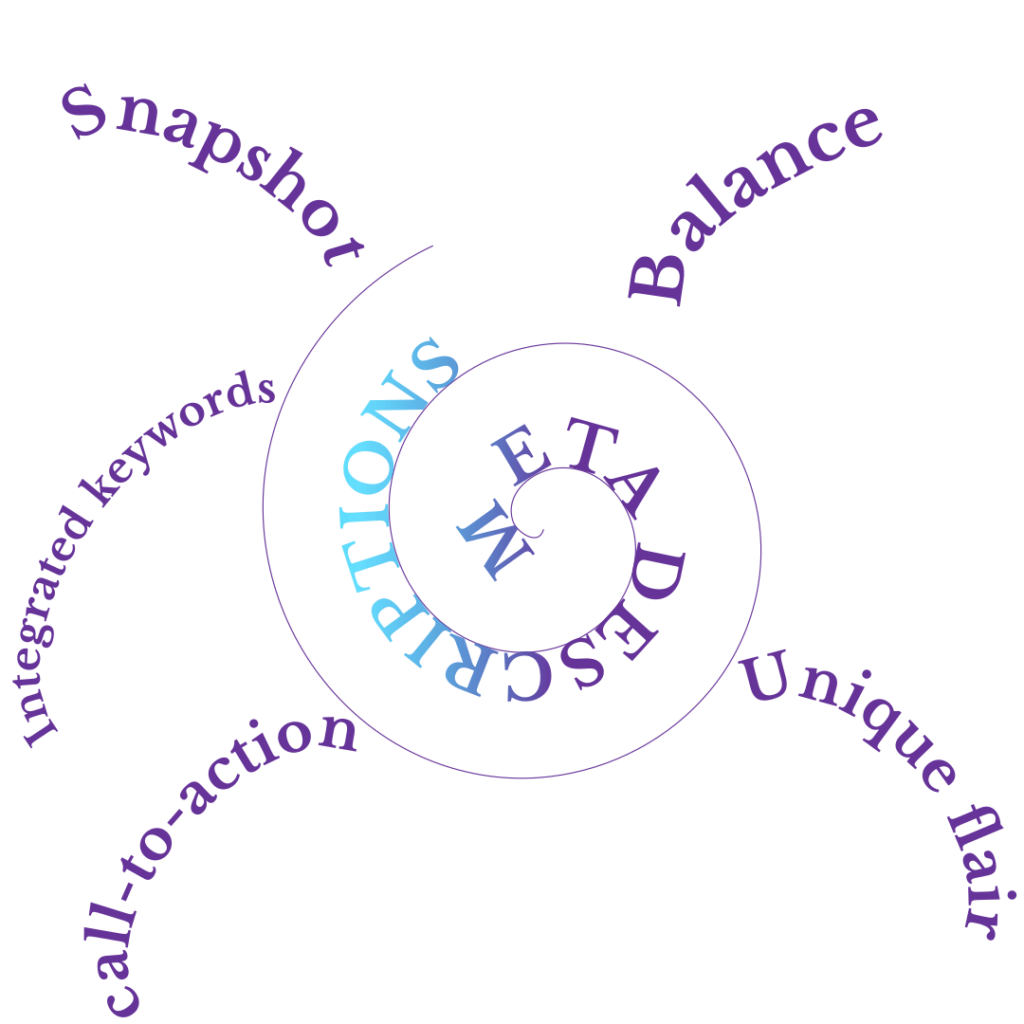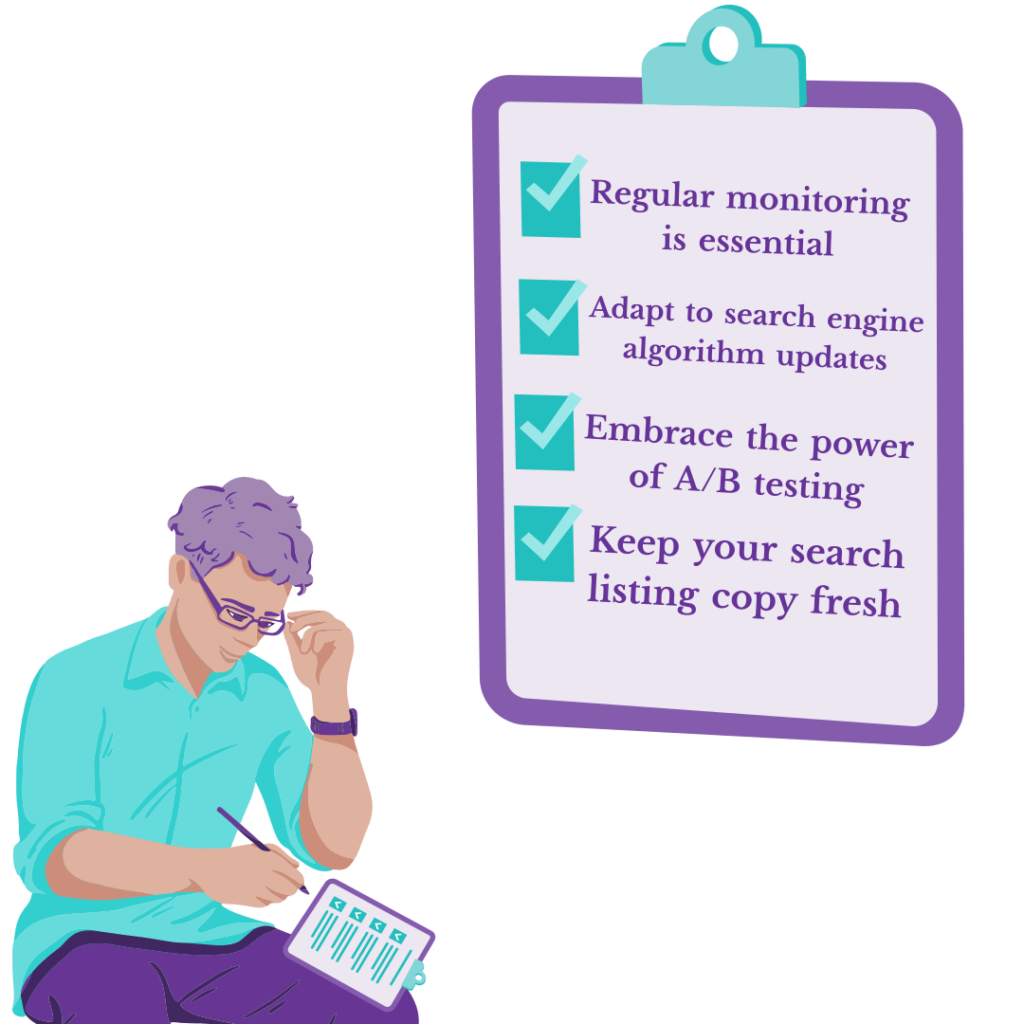Welcome to the world of digital opportunity! Whether you’re a small business owner or a beginner in the bustling arena of online commerce, understanding how to write better search listings is your key to unlocking a treasure trove of potential. In this comprehensive guide, we delve into the nuances of creating descriptions for your search listings that not only rank well in organic search (unpaid search) but also resonate with your audience and get them clicking through to your content. Read on or listen to the audio to discover how to transform your online presence. Embark on this journey with us and learn to master the art of search listings, turning searches into successful business conversions.
Table of Contents
Understanding meta descriptions and their role in SEO
In the realm of digital marketing, search listings are akin to digital shopfronts, inviting potential customers to explore what you offer. For small businesses and burgeoning entrepreneurs, mastering these listings is not just an advantage; it’s a necessity in the crowded online marketplace.

What are search listings?
At their core, search listings are the snippets of information that appear on search engine results pages (SERPs). They typically include a title, URL, and brief description or excerpt that showcases the essence of your web page. These snippets are your first — and sometimes only — opportunity to capture the attention of your audience amidst a sea of competitors.
What are meta descriptions?
A meta description is the piece of code that tells search engines what you want them to display as the description in their search listing.
Why are meta descriptions crucial for SEO?
Search engine optimisation (SEO) is the science and art of enhancing your website to improve its visibility when people search for products, services, or information related to your business. Search listings play a pivotal role in SEO and meta descriptions fulfill a major part of that role.
Your search listings are the first interaction point between your website and potential customers, and we all know how important first impressions are. Well-optimised listings can also catapult your website to the top of SERPs, significantly increasing your chances of being noticed.
The titles displayed in your search listings will ideally grab your audience’s attention. Once you have their attention, your meta descriptions are your opportunity to convince your audience that it’s in their best interests for them to click through to your content. Once they’re on your site, you then have the opportunity to prove you can solve their problems and convince them to buy from you.
If your search listings don’t feature compelling meta descriptions, your audience may pass over your content in favour of content from your competitors, offering them more opportunities to sell to your audience.
The flow-on effects of good search search listings
There’s more to search listings that just getting noticed and compelling clicks. Here are some of the longer-term, and perhaps more subtle, impacts of achieving good search listings:
- Enhanced visibility: High-ranking search listings ensure your business is visible to a larger audience. This visibility is crucial in the digital age, where being seen equates to opportunities for engagement and conversion.
- Increased trust and authority: A website that consistently appears at the top of search results is often perceived as more credible and authoritative. This perception can be a game-changer for small businesses looking to establish themselves in a competitive field.
- Qualified traffic: Optimised search listings attract visitors who are actively searching for what you offer. This means the traffic driven to your website is more likely to convert into sales, making your marketing efforts more efficient and cost-effective.
Key elements of highly effective meta descriptions

Creating effective meta descriptions is a crucial aspect of SEO that blends analytical thinking and creative flair. It can take some practice to figure out a style that works for your audience, but if you can include these elements, you’ll be well on your way to increased web traffic.
1. A story in a snapshot
Meta descriptions offer a summary of your page’s content in search results. They should be engaging and informative, but above all, accurate.
2. A balance between brevity with impact
Keep each meta description concise, ideally between 150-160 characters. This ensures they’re fully displayed in search results without being cut off. Conciseness also demands clarity – each word must add value to your message.
3. Integrated keywords
While keywords are important for SEO, they should fit seamlessly into your meta description, sounding entirely natural. Forced or excessive use of keywords can detract from the user experience and appear spammy.
4. A call-to-action
A compelling call-to-action (CTA) within your meta description can significantly boost click-through rates. Your CTA might be an invitation to learn more, discover a solution, or view a product.
5. Unique flair
Ensure every page on your website has a unique meta description. This helps differentiate your content in search results and improves the overall SEO performance of your site.
Here’s an example of how these elements can come together to produce an effective meta description for an SEO blog post: Discover top SEO strategies for small businesses. Enhance your digital footprint and drive web traffic.’
This meta description includes relevant keywords like ‘SEO strategies’ and ‘web traffic’. It’s concise (and would presumably be accurate and unique). It tells the audience why they’ll enjoy the page (the page features top strategies and it’ll help the audience achieve their goal of increasing their web traffic). And though it may not be obvious at first, it includes a CTA in the form of the word ‘discover’.
Practical tips and strategies for optimising your meta descriptions — avoid these mistakes!
Often, knowing what a good result looks like isn’t enough. You also need to know what mistakes to avoid. These are the top meta description mistakes that could seriously derail your efforts:

1. Forcing keywords
As mentioned above, while including keywords is useful, overusing them (known as ‘keyword stuffing’) can make your meta descriptions sound unnatural and may deter users. Worse, Google actively deprioritises sites that practice keyword stuffing. Many people take this info on board but still run into trouble because it’s really challenging to fit keywords into such a short number of characters.
The thing to be aware of is that you don’t have to use the exact form of a keyword to get the benefits of using it. Especially in meta descriptions. If your meta description reads better with a synonym or close variant of your SEO keyword, don’t forge ahead with the exact keyword you’re target. Balance is key for readability and effectiveness.
2. Vague and generic descriptions
Because they’re so short, a common mistake is writing meta descriptions that are too vague or generic. After all, it can be challenging to come up with a short, keyword-optimised piece of text that’s really distinct from everything else on the same or similar topics. But persevere! Your meta descriptions should be specific to the content of each of your pages and they must offer a clear value proposition to the reader. If you really can’t find a unique way of summarising your content, it may be time to assess whether your content is really unique. (Because it must be if you’re to succeed.)
3. Creating clickbait
While it’s important to make descriptions engaging, avoid misleading claims or clickbait-style descriptions that promise the Earth but don’t deliver and therefore don’t accurately reflect the page’s content. This can lead to a poor user experience and increase bounce rates, which eventually harms rankings. If you can’t think of a way to describe your page that’s both accurate and engaging, it may be time to assess whether your content is going to be engaging for your audience.
Measuring and improving: the continuous process of SEO

SEO is not a set-it-and-forget-it aspect of your digital strategy. It’s a continuous cycle of measurement, improvement, and adaptation. Understanding this ongoing process is key to maintaining effective search listings over time. So, be sure to heed these SEO maintenance necessities.
1. Regular monitoring is essential
Regularly monitor your website’s performance in organic search results. Use tools like Google Analytics and Google Search Console to track how your pages rank and how users interact with your listings. Look for trends in click-through rates and bounce rates to gauge effectiveness.
2. Adapt to search engine algorithm updates
Search engines frequently update their algorithms. Stay informed about these changes and adjust your SEO strategies accordingly. This may involve tweaking your keywords, updating content, or refining your meta descriptions.
3. Embrace the power of A/B testing
Experiment with different versions of your search listings to see what resonates best with your audience. A/B testing can reveal powerful insights into the preferences and behaviors of your target market.
4. Keep your search listing copy fresh
The internet is ever-evolving and your SERP content should be too. Regularly update your web pages and their associated meta descriptions to keep them relevant and informative. This not only helps with SEO but also ensures that your audience finds value in what you offer.
Elevating your business through SEO mastery

SEO is an ongoing process, not a one-time task. Regularly updating your listings, adapting to new algorithms, and staying informed about best practices will keep your business competitive in the ever-evolving digital landscape.
To do this, you can invest in meta descriptions from an SEO expert and have them update them every 12 months or so. Or, if that’s outside your budget, you can learn to write them yourself. And now you have the basic info you need to do just that.
So, armed with the knowledge of how to create and optimise effective meta descriptions, your next step is to put this into action. Review your current listings with a critical eye, implement the strategies discussed herein, and monitor the results. Remember, small, consistent efforts in SEO can lead to significant growth for your business.
If you need a little extra help to get you started though, or you want to learn how to optimise your whole search listings, not just the meta descriptions. Check out our ‘Write Better Search Listings’ course. It’s a no nonsense, step-by-step course that focuses on just that part of SEO, so you pay only for the skills you need right now.
Either way, don’t let your digital potential go untapped. Start refining your search listings today, and set your business on a path to greater online success. Your future customers are searching for you. Make sure they find you.
